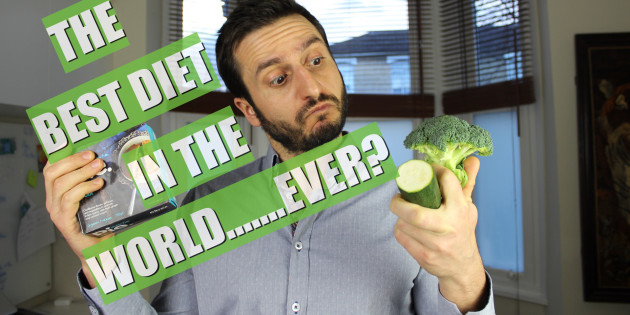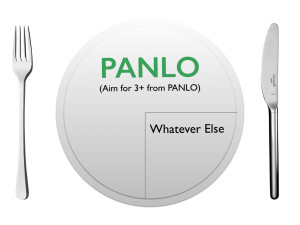I’m always being questioned about what I eat, how much, how often and so on. Why? Well, because food is a vital component to feeling super and kicking ass at work and at home.
If you are looking to perform at the highest level, then you need to get the nutrition angle sorted.
Food, nutrition is a highly charged and divisive topic where we could spends years debating the merits between paleo and vegan, 5:2 fasting versus intermittent fasting, farm to table versus wild, Atkins versus South Beach, Zone versus ….. well, you get the picture.
I’ve been a student of nutrition somewhat ferociously for the last 5 years and this I know…. Things are always changes. The good guys in food, the bad guys. But I also know the following. What I believe works best for most people I’ve met, most of the time. It also happens to be what the best eating styles often agree on.
I call it PANLO 80/20, or P.A.N.L.O. 80/20
It’s so called because PANLO stands for the 5 areas or questions to look out for when choosing food.
P – Plant Based
Almost everyone universally agrees that veggies are good for you. In fact, they are super for you. Full of fibre, micronutrients, antioxidants, protein, fats and carbohydrates. We should all be eating more plants. Our diets should be plant based and whether or not you choose to eat animals or consume animal products, the overwhelming evidence and consensus is that getting your greens in, is good.
So my first question I ask is:
“Is what I’m about to eat plant-based?”
“Is my meal plant-heavy?” (i.e. loaded with vegetables above and beyond anything else)
So the first criteria and what I believe (through experience, observations and research) is key, is that the food is plant-based.
A – Alkaline
You may remember something of the pH scale from high school biology and chemistry. It’s a measure of acidity (0) to alkalinity (14) with neutral in the middle at 7.
The body has different pH levels depending on the organ we’re talking about, but one of the best indicators of health, is a healthy blood. The blood has a pH around 7.365 (give or take a narrow band). It will stay in this range because not to, would spell disaster. But when you consume lots of acid forming products the body has to work harder to maintain that healthy range. Drawing on nutrients from elsewhere in the body (like the organs – kidney, liver etc, skin, bones, and so on) to neutralise the acidity. It takes significantly more alkalinity to neutralise the acidity that comes in, and so our diet should be skewed towards alkaline items (not 100%, but as you’ll see, it’s very easy to create acid in the body and so 80% or so of the diet should be alkaline).
Acid can be created in the body through a number of ways. Food like sugar, meat, diary, processed foods, cola’s, coffee, alcohol and even many fruits. Also, you can create an acidic environment through stress, pollution, hard/excessive exercise and lack of sleep.
So essentially, it’s very hard to avoid create some level of acidity in our bodies. So our diet should be skewed towards alkalinity. I have a complete food chard in my course (http://thethoughtgym.com/superenergy/ ) if you’re interested, which is essentially an amalgamation of many other charts – because there’s always a bit of discrepancy between the charts.
But in short, vegetables are generally alkaline. Some fruits, like tomatoes, avocado’s and lemons/limes (although acidic, have alkalising effect on the body). Everything we’ve discussed above is acidic but so are many grains, and beans and nuts/seeds.
Of course, you don’t want 100% alkaline, so some beans, nuts/seeds and (in my opinion – see previous post on March Favourites) gluten-free grains, would be fine.
N – Natural
We’re living in an every increasing UN-natural world. How we eat, move, exercise and eat are not natural patterns. We stay awake later than we should – not following the natural rhythms of nature (forgetting that we (everyone and everything) on this planet is part of one symbiotic system) – to our detriment.
So when it comes to food, does what you’re about to eat look like it came from nature?
Could you recognise it in a field?
If not, then minimise the consumption of it.
For example, if I’m cooking a curry and it’s full of broccoli – I can recognise that as broccoli. I don’t see many chicken nuggets roaming around in pens anywhere. I don’t see many veggie-burgers or meat burgers outside the shop or restaurants?
Think simple. Does it look like nature gave it to me?
Even grains are as nature presents them to us. They are processed by man. So this isn’t about nothing UN-natural, but just get some awareness over it. You can’t go into a supermarket and buy your gluten-free vegan brownie and think that’s healthy or natural. It’s not. Okay, you might find a uber ‘healthy’ brownie homemade by some market stall person full of spirulina and chia, but it’s still not a naturally occurring brownie!
Just limit that which isn’t natural.
L – Live / Lightly Cooked
Cooking food has some benefits. It softens it for us to chew on and releases other nutrients sometimes not available in raw food. However, introducing more live (raw) and lightly cooked (e.g. steamed, stir-fried, steam-fried) which allow many more enzymes and nutrients to be accessible to you and the life force of the food is transferred to you. I know this might sound weird, but there is an energy inherent in all things (E=mc2, anyone?) and this energy from most of the plants we might eat is reduced when cooking. Check out Kirlian photography for some visual demonstrations.
But better still, start introducing more live foods (salads etc) and decide for yourself whether you start to feel like you have more energy.
O – Organic
Lastly, I consider whether the food is organic or not. I’m not super fastidious about this, but it’s an ever growing presence for me now. I have a weekly organic veg delivery from local farms and definitely organic hummus (yes, I know – not natural) definitely tastes better compared to regular hummus.
Think about this. If there are products being sprayed onto farmland to kill insects etc, the plants are being sprayed with things designed to kill. I.e. something poisonous to some things at least. This gets into the soil, the plants draw this up. Do you really want to eat that?
There is some evidence coming though to show that organic food has more antioxidants and less toxic residue. Check out the article here: http://www.theguardian.com/environment/2014/jul/11/organic-food-more-antioxidants-study
There was also an interesting experiment with the one family where they ate non-organic and then went organic for 2 weeks. Before the experiments there were significant levels of pesticides in their urine. After two weeks. Virtually none. Are you sure you want that in your body?
Like I say, I’m not anal about this. But at home for the majority of the time, I try and buy organic. If my food runs out, and I do a local shop, I’ll get what’s there. If I’m out with people at a restaurant, I’ll eat what’s there and best choice.
In your own home, where you are king/queen of your domain, perhaps think about it?
80/20
So, that’s the bit about PANLO dealt with. What about the 80/20? This simply means do PANLO as much as you can. Maybe 4 meals out of 5, or just over 3/4 of your plate.
And with the PANLO idea, I would rarely get all 5 PANLO items, but if you can aim for 3+ PANLO ideas 80%+ of the time, you will notice a big change.
I’m on a mission to get this PANLO 80/20 idea more widespread as it allows for more flexibility that most and I believe covers the essential elements. I may put together a LiveWell style plate one day and will go into more detail with things like fats (which most people are still afraid of! You shouldn’t be – even saturated fat. Just as long as not processed and from natural sources, as a rule of thumb, it’s okay), water, oils, superfoods and so on.
But for now, just follow PANLO 80/20 and watch your life soar to new levels.
For each meal ask yourself
Is this food plant-based?
Is it alkaline?
Do it look like something I would recognise in nature?
Is it live/raw or just lightly cooked?
Is it organic?
Aim for 3 or more yes’s and you’re good to go!
Let me know what you think. Comment below and please remember to share this concept with others. I feel many people can benefit.











